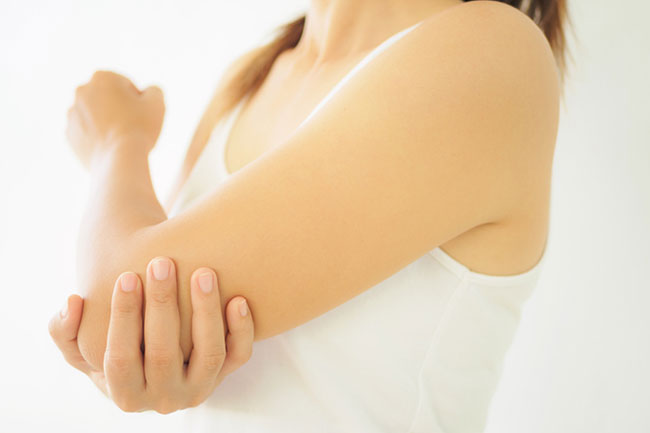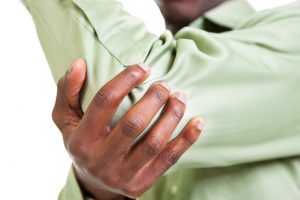
It takes twenty-three muscles to give your elbow stability and flexibility.
The major muscles involved in bending your arm are the triceps—on the back of your arm—and biceps, on the front of your arm. Your many smaller flexor and extensor muscles allow you to move your wrists and fingers and rotate your forearm.
(source)
Elbow Pain
Your elbow is a complex joint. It allows you to extend and flex, as well as rotate your hand and forearm. It lets you throw, lift, swing and hug – and flip pancakes. Because of the elbow's complexity, it is often difficult to describe exactly which elbow movement is causing you pain.
Your elbow joint is the union between three bones: your upper arm bone, called the humerus, and the ulna and the radius, the two bones that make up your forearm. On the end of each bone there is a layer of cartilage that acts as a shock absorber and allows them to slide against each other.
Overuse is the chief cause of elbow pain. Many jobs, hobbies and sports require repetitive hand, wrist or arm movements. These movements can put a strain on the tendons that connect your bones to muscles and allow you the ability to move your arm in different ways. While arthritis rarely occurs in your elbow, it is the tendons that usually produce the pain you are feeling.
Tennis Elbow and Golfer's Elbow

These are both types of tendinitis, which means you have inflammation around your elbows due to overuse. Despite the names, these injuries aren’t limited to athletes. Anyone who uses the same repetitive movements can develop this condition. Tennis elbow, known as lateral epicondylitis, affects the outside of your elbow, while golfer’s elbow, known as medial epicondylitis, affects the inside of your elbow.
Bursitis
Bursae are small sacs of fluid in your joints that help cushion your bones, tendons and muscles. They also help skin slide over the bone. These sacs can get swollen from an accident or infection, but they usually get inflamed from overuse. This condition is called bursitis.
Other Elbow Injuries
You may be familiar with your “funny bone.” This is the nerve that runs through your elbow, and when bumped, it sends a tingling or buzzing sensation down your arm. This nerve can become entrapped in the joint, and can cause general weakness and loss of sensation in your hand and fingers. A stress fracture can also be a source of pain in the elbow. This is a small crack in one of your arm bones often caused by overuse. Stress fractures occur more commonly in athletes who throw a lot, but can also occur as the result of an accident or fall.
Physical Therapy and Elbow Pain

The first step in dealing with elbow pain is evaluating the source of that pain. If your pain is the result of an accident, it is important to see a physician to determine whether or not there is a fracture that needs to be dealt with first. A physical therapist can assess your current strength and flexibility capabilities. He or she will be able to note the specific arm movements that cause pain and develop a treatment plan to help relieve your pain and restore full use of your elbow. This course of treatment will also help you increase flexibility and build strength, but will also provide you with the necessary tools to maintain your pain-free life.
When you’re ready to get started with one of our experts at Progressive Physical Therapy, call us toll-free at (877) 342-2669 or register online for a consultation. You'll soon be on the way to relieving yourself from elbow pain.


